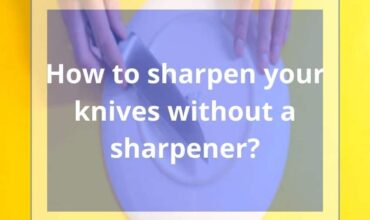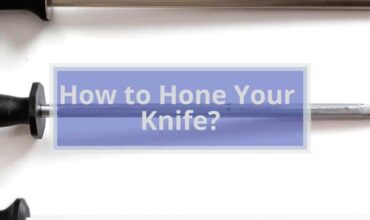One of the most important factors for keeping your knives razor-sharp all the time is knowing the difference between Honing and sharpening.
It is so irritating to get squished tomatoes and smashed cakes every time you try to slice them, right? So to avoid that you need to know what honing and sharpening processes really mean, to make the most of them.
What Makes a Knife Blade Dull?
A stainless steel knife is definitely harder than anything you may need to cut. That’s why dulling a cutting edge is relatively low if you aren’t dealing with hard surfaces and objects.
When your knife edge turns to a dull knife, it is probably because the sharp knife edge started to roll over. and not that the knife’s blade became dull.
There are two factors that can cause a knife to be dull:
1) The sharpness of the edge has decreased.
2) The edge of the blade has become uneven.
In other words, a kitchen knife that requires sharpening is the one that has a damaged “tooth.”.
Honing vs. Sharpening
First, Honing
A knife Honing is nothing more than the process of maintaining a razor-sharp edge. Where a steel honing rod is used to align that knife edge.
This procedure is also known as “folding back the burr.”
What is a honing steel?
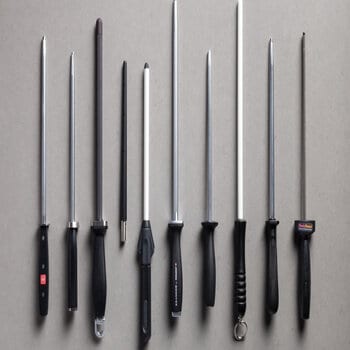
It is made up of a 12-inch steel rod with a handle on one end and a rounded edge on the other end.
The handle is the thickest part that grows thinner as it comes closer to the rounded end.
Honing steel is commonly found in most professional and high-end kitchen knife sets. It is very popular among home cooks because it is very easy to use and affordable.
Read also , Things to Consider When Buying an Electric Knife Sharpener
When to Hone your Knives?
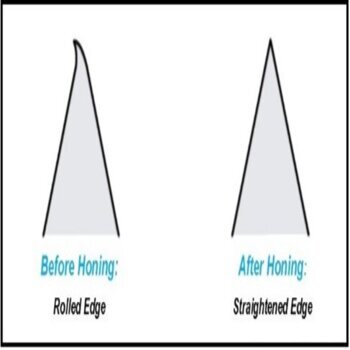
The first thing to keep in mind is that knife honing does not technically sharpen knives. However, it sharpens the knife’s edge and makes your blade last longer.
When you use a sharp knife, it will undoubtedly encounter a hard surface. Whether it is a wooden cutting board or a piece of chicken bone.
When the fine edge strikes these hard surfaces, it bends and folds because of the force.
Since these foldings are too small to be noticed at first glance. These hundreds of tiny teeth on the end of the blade are on the microscopic level to visualize.
They don’t feature a lot of strength as being so thin. So folding or rolling over can rapidly occur once they hit a hard surface.
As a result, the harsher the knife hits the surface, the faster the blade will roll over.
Therefore, an end-grain wooden cutting board is an ideal option when using a high-end blade. while a marble cutting board can cause a lot of damage to your knife. ( want to know the best material for cutting boards?)
What is the purpose of a steel honing tool?
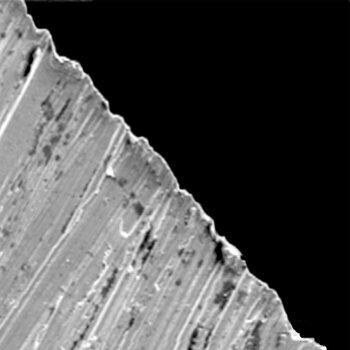
Most knife blades are made from steel. It is best to use steel honing steel. Since you need to use a tool that features the same strength of the teeth to realign them back in place.
The honing steel will straighten the blade’s edge smoothly. So, the knife turns sharper after realigning the teeth in place, even if few remain unaligned.
In conclusion, it is an effortless and straightforward procedure. All you need to do is three or five strokes on each side to realign the blade back in place.
What are the Types of Honing Rods?
honing rods come in various types and materials, including ceramic sharpening steel, diamond sharpening steel, and stainless steel rod.
You have to get the one that suits your knives the best.
Check also, Best Bread Knife Review
Steel honing rod
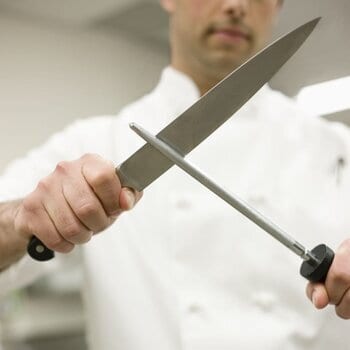
A honing rod features a more robust material than your knife’s material. that’s why most standard honing rods included in common knife sets are not the best option.
Since high-end knives are made from a more robust material compared to that of a honing rod. You will get poor honing results.
Also, as a general, steels rods are much weaker than any Japanese knives made from carbon.
Honing rods can create small tears in the knife and cause harm to the knife’s blade. Besides, you will need to resharpen your knives more often.
Ceramic hone rod
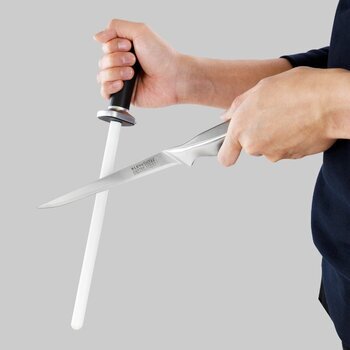
The ceramic rod features a fine grit which is gentler on most high-end knives. Besides, they are 3 times stronger than steel rods. minimizing any excessive metal grinding.
Ceramic honing rods are extra affordable than most honing steels. But they are more fragile and can be broken easily.
Diamond steel
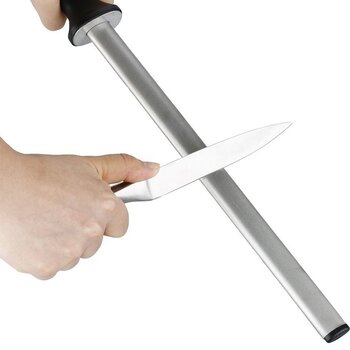
Diamond steel is the best material for an abrasive grinding wheel. Whether for a manual knife sharpener or an electric sharpener.
But the drawback is they may remove more metal from the knife than you need.
How Often Should you Hone your Knives?
it is recommended to hone your knife regularly. For the best results, sharpen them after 3 uses.
When you look at the knife’s edge on a microscopic level. You will discover the edge alignments start to bend immediately after using them.
Since the tiny teeth on the blade’s edge are so fragile. They start coming out of alignment when hitting a hard surface while slicing or chopping.
Read more , How to Care for Your Paring Knife?
How to Choose the Best Steel Honing Rod?
Here are some elements you should pay attention to when buying a steel rod
Length
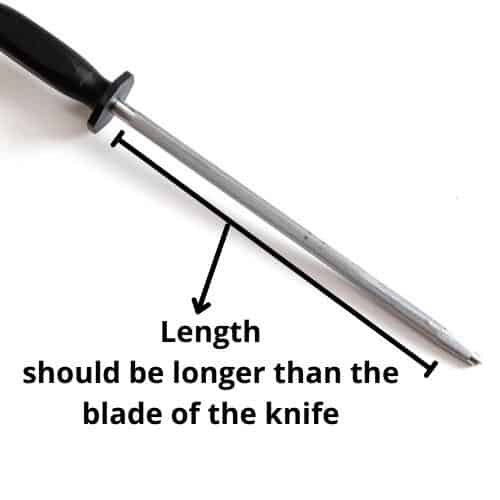
The length of your honing steel should always be at least as long as your knife blade or a little longer. This will let you hone the entire edge with one stroke. and will ensure that the whole blade features a uniform edge along its edge.
Material

The two most popular materials used in producing honing rods are steel and ceramic. we discussed each in detail, So just pick up the material that works well with your knife type.
Second, sharpening
Sharpening is the procedure of removing material off a blade’s edge. Which is commonly performed by grinding it over a sharpening stone.
Depending on how often you use your knife, You do not need to sharpen it more than twice a year if you are honing it consistently.
Sharpening takes material from the blade to create a new, sharp edge.
What is a Knife Sharpening Steel?
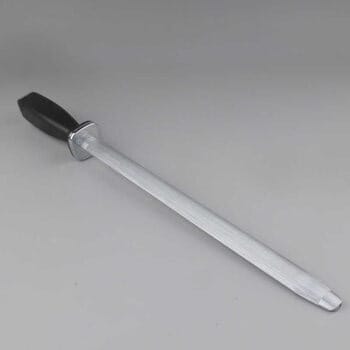
The reason for mixing between both terms is that many marketers call it sharpening steel.
As a matter of fact, sharpening tools are not made of any steel. They are composed of durable blendings of steel.
As a result, you will get ultra strong sharpeners that can sharpen your knives properly.
Read more , How to shuck oysters without an oyster knife?
What is the Purpose of the Sharpening Tool?
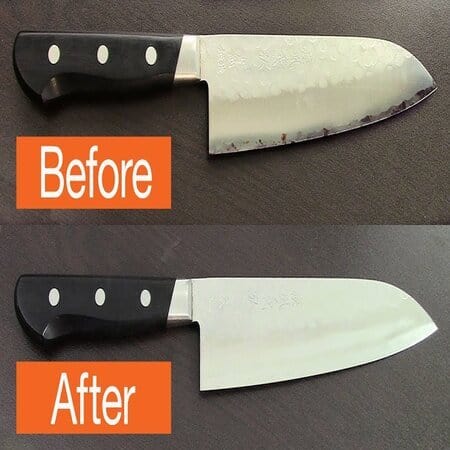
Sharpening tools are used to maintain the knife’s edge straight and sharp after each use. After continuous usage of the blade, it becomes a dull blade. and the edge curls out of alignments.
Sometimes this misalignment or curling becomes too hard to be fixed by honing only. so you’ll need to reveal a new edge for the blade.
Thus, sharpeners need to be made of a more aggressive, robust structure than knives. they are commonly known as whetstones or water stones.
The reason behind using such strong materials is the need to reveal a thin layer of the blade’s edge. to uncover the new and sharp edge below it.
Also, the thin layer removed is composed of microscopic particles like steel dust which cannot be shaved with similar strength to the blade.
How Often Do you Need to Sharpen Your Knives?
I suggest getting them properly sharpened every 1-2 years.
And if you hone your knives regularly. You will only need to sharpen your knife every six months or a year.
Sharpening can be more harmful to your knife than honing. Since honing realigns a current knife’s edge while sharpening, remove a segment of your knife.
It is known that you should sharpen your knives every 6 months, but this is wrong. and you can end up wearing your knife blade quicker.
Also read , How to Hone Your Knife? | Easy Guide
What are the Types of Sharpening Steel?
Diamond Sharpening Steel
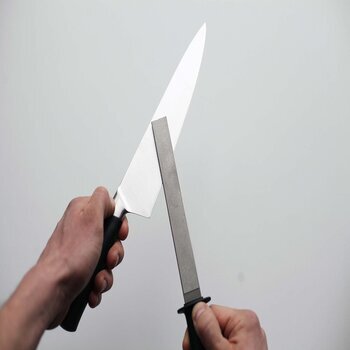
A diamond sharpening steel is used to shave the blade’s edge and reveals a new sharper edge.
It can remove a significant amount of steel off with each strike, because of its abrasive surface,
Ceramic and Titanium Sharpening Steel
A ceramic sharpening steel and Titanium sharpening steel are classified as intermediate-quality sharpeners.
You can alternate between both to maintain the knife’s edge. As one can remove steel, and the other sets back the teeth into alignment.
Steel Sharpening Steel
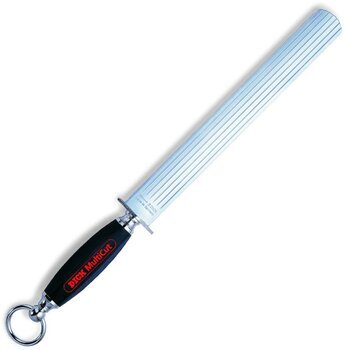
Steel sharpening steels are basically made from bevel steel. Their primary usage is to flatten the edge after a couple of uses instead of sharpening or setting the edge.
How to Choose the Best Sharpening Steel?
Length
Sharpening steel length can be determined using the same criteria as honing steel length. So, the sharpening rod should be longer than your longest blade.
Material
Sharpening rods are abrasive in comparison to honing rods. Diamond steel is the most common material used in sharpening rods to remove material.
Also check, What are the Benefits of Oysters?
Which is More Essential Honing or Sharpening your Knife?
When caring for knives properly, they are honed more regularly than sharpening them. You can even hone after each use, like preferred by many chefs.
Since sharpening knives actually remove materials off the blades. This is why you should only shapen them when needed.
Sharpening a knife should only be applied when honing doesn’t work to realign the teeth on edge.
As a general rule, sharpening a knife a few times throughout the year is a must. How frequently to sharpen them relies mainly on the way and the number of times you use them.
It is best to use different techniques when honing or sharpening your knives. Besides honing, steel should always be available to keep your edges sharp, strong, and ready to use.
Yet, sharpening knives is a valuable process to carry out with many alternatives. Such as electric knife sharpeners, whetstones, or at a workshop for sharpening knives. (want to know how to sharpen your knives without a sharpener?)
Final thoughts
Now you know the difference between honing and sharpening, we expect you to never have a single dull knife on your kitchen drawer!
